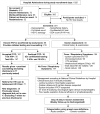Causes of acute hospitalization in adolescence: burden and spectrum of HIV-related morbidity in a country with an early-onset and severe HIV epidemic: a prospective survey
- PMID: 20126383
- PMCID: PMC2814826
- DOI: 10.1371/journal.pmed.1000178
Causes of acute hospitalization in adolescence: burden and spectrum of HIV-related morbidity in a country with an early-onset and severe HIV epidemic: a prospective survey
Abstract
Background: Survival to older childhood with untreated, vertically acquired HIV infection, which was previously considered extremely unusual, is increasingly well described. However, the overall impact on adolescent health in settings with high HIV seroprevalence has not previously been investigated.
Methods and findings: Adolescents (aged 10-18 y) systematically recruited from acute admissions to the two public hospitals in Harare, Zimbabwe, answered a questionnaire and underwent standard investigations including HIV testing, with consent. Pre-set case-definitions defined cause of admission and underlying chronic conditions. Participation was 94%. 139 (46%) of 301 participants were HIV-positive (median age of diagnosis 12 y: interquartile range [IQR] 11-14 y), median CD4 count = 151; IQR 57-328 cells/microl), but only four (1.3%) were herpes simplex virus-2 (HSV-2) positive. Age (median 13 y: IQR 11-16 y) and sex (57% male) did not differ by HIV status, but HIV-infected participants were significantly more likely to be stunted (z-score<-2: 52% versus 23%, p<0.001), have pubertal delay (15% versus 2%, p<0.001), and be maternal orphans or have an HIV-infected mother (73% versus 17%, p<0.001). 69% of HIV-positive and 19% of HIV-negative admissions were for infections, most commonly tuberculosis and pneumonia. 84 (28%) participants had underlying heart, lung, or other chronic diseases. Case fatality rates were significantly higher for HIV-related admissions (22% versus 7%, p<0.001), and significantly associated with advanced HIV, pubertal immaturity, and chronic conditions.
Conclusion: HIV is the commonest cause of adolescent hospitalisation in Harare, mainly due to adult-spectrum opportunistic infections plus a high burden of chronic complications of paediatric HIV/AIDS. Low HSV-2 prevalence and high maternal orphanhood rates provide further evidence of long-term survival following mother-to-child transmission. Better recognition of this growing phenomenon is needed to promote earlier HIV diagnosis and care.
Conflict of interest statement
The authors have declared that no competing interests exist.
Figures
Comment in
-
Adolescent HIV--cause for concern in Southern Africa.PLoS Med. 2010 Feb 2;7(2):e1000227. doi: 10.1371/journal.pmed.1000227. PLoS Med. 2010. PMID: 20161804 Free PMC article.
Similar articles
-
Skin disease among human immunodeficiency virus-infected adolescents in Zimbabwe: a strong indicator of underlying HIV infection.Pediatr Infect Dis J. 2010 Apr;29(4):346-51. doi: 10.1097/INF.0b013e3181c15da4. Pediatr Infect Dis J. 2010. PMID: 19940800 Free PMC article.
-
HIV infection presenting in older children and adolescents: a case series from Harare, Zimbabwe.Clin Infect Dis. 2007 Mar 15;44(6):874-8. doi: 10.1086/511873. Epub 2007 Feb 1. Clin Infect Dis. 2007. PMID: 17304463
-
Undiagnosed HIV infection among adolescents seeking primary health care in Zimbabwe.Clin Infect Dis. 2010 Oct 1;51(7):844-51. doi: 10.1086/656361. Clin Infect Dis. 2010. PMID: 20804412 Free PMC article.
-
Human immunodeficiency virus and AIDS in Uganda.East Afr Med J. 1996 Jan;73(1):20-6. East Afr Med J. 1996. PMID: 8625856 Review.
-
Update on HIV/AIDS in Thailand.J Med Assoc Thai. 2001 Jun;84 Suppl 1:S1-17. J Med Assoc Thai. 2001. PMID: 11529320 Review.
Cited by
-
HIV-infected adolescents in southern Africa can achieve good treatment outcomes: results from a retrospective cohort study.AIDS. 2013 Jul 31;27(12):1971-8. doi: 10.1097/QAD.0b013e32836149ea. AIDS. 2013. PMID: 23525033 Free PMC article.
-
Burden of HIV among primary school children and feasibility of primary school-linked HIV testing in Harare, Zimbabwe: a mixed methods study.AIDS Care. 2013;25(12):1520-6. doi: 10.1080/09540121.2013.780120. Epub 2013 Mar 26. AIDS Care. 2013. PMID: 23528004 Free PMC article.
-
Longitudinal Changes in Spirometry in South African Adolescents Perinatally Infected With Human Immunodeficiency Virus Who Are Receiving Antiretroviral Therapy.Clin Infect Dis. 2020 Jan 16;70(3):483-490. doi: 10.1093/cid/ciz255. Clin Infect Dis. 2020. PMID: 30938406 Free PMC article.
-
Perception of risk of vertically acquired HIV infection and acceptability of provider-initiated testing and counseling among adolescents in Zimbabwe.Am J Public Health. 2011 Dec;101(12):2325-32. doi: 10.2105/AJPH.2011.300250. Epub 2011 Oct 20. Am J Public Health. 2011. PMID: 22021300 Free PMC article.
-
Caring for Adolescents and Young Adults With Tuberculosis or at Risk of Tuberculosis: Consensus Statement From an International Expert Panel.J Adolesc Health. 2023 Mar;72(3):323-331. doi: 10.1016/j.jadohealth.2022.10.036. J Adolesc Health. 2023. PMID: 36803849 Free PMC article.
References
-
- Caflisch M, Alvin P. Management of adolescents in pediatric hospitals. A national survey. Arch Pediatr. 2000;7:732–737. - PubMed
-
- Rosen EU. Adolescent health problems–can paediatricians in the RSA cope? S Afr Med J. 1988;73:337–339. - PubMed
-
- Obasi AI, Balira R, Todd J, Ross DA, Changalucha J, et al. Prevalence of HIV and Chlamydia trachomatis infection in 15–19-year olds in rural Tanzania. Trop Med Int Health. 2001;6:517–525. - PubMed
-
- Agyei WK, Epema EJ, Lubega M. Contraception and prevalence of sexually transmitted diseases among adolescents and young adults in Uganda. Int J Epidemiol. 1992;21:981–988. - PubMed
Publication types
MeSH terms
Grants and funding
LinkOut - more resources
Full Text Sources
Medical
Research Materials


